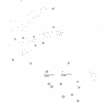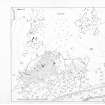Learable
Burial Cairn (Bronze Age), Cist (Bronze Age), Cremation (Bronze Age), Bead(S) (Jet)(Bronze Age), Cinerary Urn (Bronze Age), Razor (Bronze)(Middle Bronze Age)
Site Name Learable
Classification Burial Cairn (Bronze Age), Cist (Bronze Age), Cremation (Bronze Age), Bead(S) (Jet)(Bronze Age), Cinerary Urn (Bronze Age), Razor (Bronze)(Middle Bronze Age)
Alternative Name(s) Lierabol; Learable Hill
Canmore ID 6721
Site Number NC82SE 9
NGR NC 8922 2351
NGR Description NC 8926 2350, NC 8923 2352 and NC 8922 2351
Datum OSGB36 - NGR
Permalink http://canmore.org.uk/site/6721
- Council Highland
- Parish Kildonan
- Former Region Highland
- Former District Sutherland
- Former County Sutherland
NC82SE 9 8922 2351.
('A' : NC 8926 2350 'B' : NC 8923 2352 'C' : NC 8922 2351) Cairns (NR).
OS 6" map, (1962)
'A' : a cairn 31' in diameter and 2' to 3' high.
'B' : a low circular cairn about 20' in diameter and 2' high, its outline defined by almost contiguous boulders, 1' to 1 1/2' long, protruding to a height of 6" to 8".
'C' : a cairn about 42' in diameter; its outline defined by almost contiguous boulders, 2' to 3' long, protruding to a height of 1'. Near the centre lies the covering slab of a cist, which during excavation of the cairn before 1886 was found to contain a burnt interment and jet beads. Close beside one of the peripheral stones an inverted cinerary urn was found covering a deposit of human bones among which lay a Middle Bronze Age bronze razor. This probably represents a secondary deposit in the cairn. The razor, beads and urn are in Dunrobin Museum. There are many probable field clearance heaps in the area and the RCAHMS (RCAHMS 1911, visited 1909) also note 'low irregular mounds which have the appearance of banks of old enclosures'. The distances of the cairns in relation to the standing stone (NC82SE 1) are erroneous.
J Anderson 1886; C M Piggott 1944; J M Coles 1964; Visited by OS (W D J) 29 May 1961
Of the three aforementioned cairns ('A' - 'C') situated on a prominent spur, 'C' is as described. The cinerary urn is still in Dunrobin Museum (Accession no 1870-2), but the beads and the MBA razor were not seen. The alleged cairns 'A' and 'B' occur within an area of scattered field clearance heaps (see NC82SE 16), 'A' being larger than most of the heaps. Neither exhibits any "cairn-like" features; the outline of boulders around 'B' appears to be a fortuitous arrangement. All heaps are heather-covered. On balance it seems more likely that 'A' and 'B' are clearance heaps rather than cairns.
Visited by OS (J B) 7 February 1977
Field Visit (6 June 1991)
This cairn is situated on the SE spur of Learable Hill some 30m W of the cross-incised standing stone (NC82SE 1). The cairn measures 11.8m in diameter and stands 0.8m in height and a number of kerbstones survive in situ on the E, S and W. The interior has been excavated, but not back-filled, leaving a large hole, into which a flat stone has been tipped. The area surrounding the cairn is covered with small cairns (NC82SE 16) and there is a stone row to the N (NC82SE 6). (KILD91 430)
Visited by RCAHMS (PJD) 6 June 1991.


















